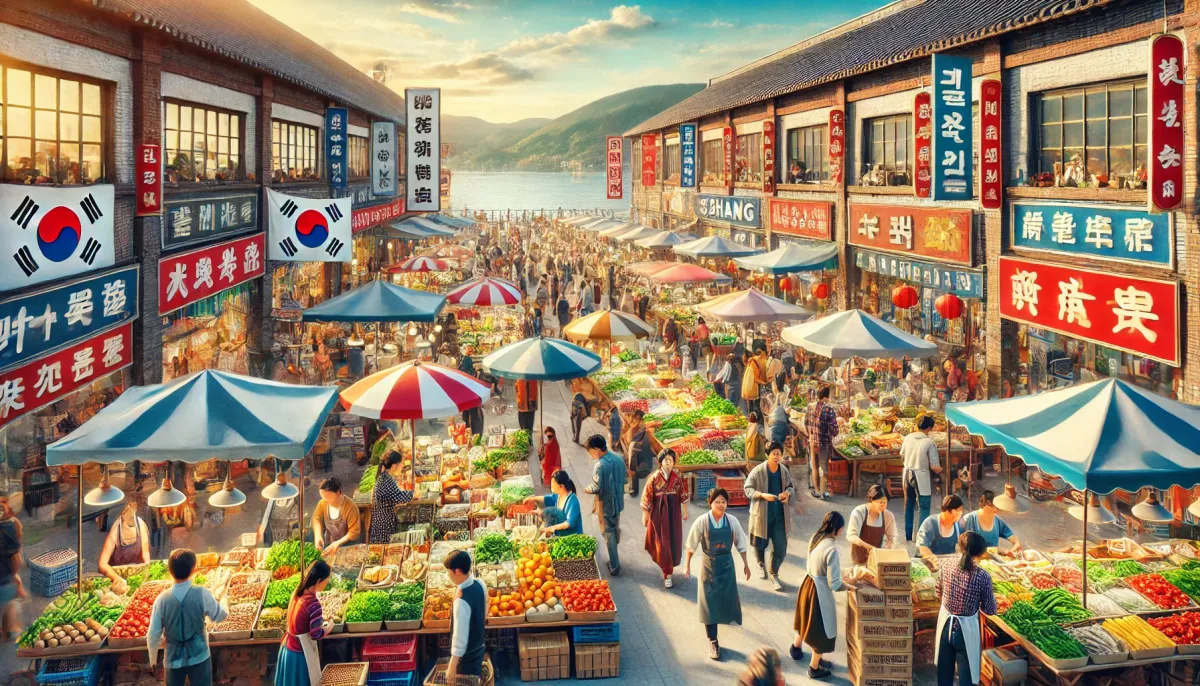Hi everyone, Mark here! I’m an avid backpacker from the US, and my passion lies in exploring the vibrant cities and hidden gems of Asia. Today, I’m sharing my incredible experience in Yanji, the capital city of the Yanbian Korean Autonomous Prefecture in China. This prefecture sits at the fascinating tri-point border of China, North Korea, and Russia, making it a unique and unforgettable travel destination. I spent a day exploring Yanji's largest morning market, the Shui Shang Market (Water Market), and the bustling Xi Market, immersing myself in the delicious food and rich culture of this border city.
A Journey Through Yanbian's Culinary Heart
My adventure began at the Shui Shang Market, a vibrant hub brimming with activity. This isn’t your typical market; the market is located right on the Yanji River (Yanjihe River), adding a unique scenic element to the experience. It was a sensory explosion! The air was filled with the aromas of freshly prepared food, the sounds of friendly chatter in both Mandarin and Korean, and the sights of bustling vendors showcasing their wares. The market operates from around 6 am to 9 am, and I was immediately struck by the blend of open-air stalls and permanent indoor vendors. The open-air stalls are run by vendors who pay a minimal fee (usually 5 to 10 RMB or about $0.70 - $1.40 USD) to the market management. Inside the market, vendors pay monthly or annual fees for their stalls.
The market was a feast for the eyes and stomach! I sampled various delicacies, including:
| Food Item | Price (RMB) | Price (USD) | Notes |
|---|---|---|---|
| Dagaos (rice cakes) | 10 | 1.4 | Sweet and chewy, coated in flavored soybean powder, red bean powder, sugar, and sesame. |
| Seafood Scallion Pancakes | 14-16 | 2.0-2.3 | Filled with shrimp, kimchi (Korean pickled cabbage), carrots, and leeks. |
| Yanbian Dog Meat | 48 | 7.0 | A traditional dish, although consumption is declining among younger generations. |
| Korean Spicy Stir-fried Rice Cakes | 12 | 1.7 | Made with glutinous rice and a rich, sweet and spicy sauce. |
| Korean Rice Sausage (Sundae) | 10 | 1.4 | Made with rice, glutinous rice, and various grains, traditionally stuffed in pig intestines. |
| Pumpkin Steamed Rice | Varies | Varies | Unique dish with rice and red dates stuffed inside halved bell peppers. |
| Korean Fish Cakes | 10 (3 pcs) | 1.4 (3 pcs) | Variety of flavors, including cheese, pineapple, banana, and red bean. |
| Various Kimchi | Varies | Varies | A staple Korean side dish with different levels of spiciness and fermentation. |
| Ginseng | 100-300 | 14-42 | A prized medicinal herb grown in the region. |
One particularly memorable experience was at the Mingyue Soup Restaurant. Even at 7 am, it was bustling with customers enjoying a hearty breakfast. I tried their Ginseng Chicken Soup (Samgyetang), a flavourful and nutritious broth. I paired it with chicken rice (Dakbap), made with glutinous rice cooked in chicken broth, goji berries, and dates. The broth was incredibly flavorful and the chicken was incredibly tender! The chicken rice was a bit more sticky than typical glutinous rice, with a savory and oily taste.
Beyond the Shui Shang Market: Exploring the Xi Market
After a delightful morning at the Shui Shang Market, I headed to the Xi Market, the largest comprehensive market in Yanji. This market offered a wider variety of goods, including fresh produce, seafood, clothing, and local specialty products. The air was thick with the scent of dried fish, particularly the ubiquitous mingtaiyu (Alaska pollock), a staple of the region. I picked up some dried mingtaiyu, along with various other local treats, including kimchi, gyulgeong (balloon flower root), and gogi (beef tendon).
Here are some key insights from my Xi Market experience:
- Mingtaiyu (Alaska Pollock): A cornerstone of the Yanji diet, this fish is dried and often sold with various dipping sauces.
- Kimchi: An enormous selection of kimchi, showcasing the region's culinary heritage.
- Beef Tendon and Balloon Flower Root: Popular side dishes known for their unique textures and flavors.
- Russian Imports: Due to Yanji's proximity to Russia, you'll find a surprising number of Russian goods, including chocolates and vodka.
The Xi Market also housed a large section dedicated to long-white mountain specialties, including wild mushrooms, ginseng, and pine nuts. I even saw some incredibly large songrong (matsutake mushrooms), though at 200-280 RMB per jin (approximately $28-$40 USD), they were a bit out of my budget!
Yanji's Location and Cultural Significance
Yanbian Korean Autonomous Prefecture's strategic location at the tri-point border of China, North Korea, and Russia makes it a unique cultural crossroads. Its border with North Korea is just across the Tumen River. With a border exceeding 760 kilometers (approximately 472 miles), it's a significant geopolitical area. The Korean population in Yanji constitutes 54% of the city, significantly influencing its culture and traditions.s, and happy shoppers.







